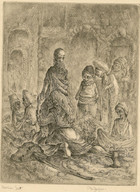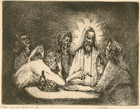Karnig Nalbandian
(1916-1989)
A biography of Eudora Welty makes brief mention of “Etcher” Karnig Nalbandian with whom the famous writer shared a farmhouse in the summer of 1941 at the Yaddo artists’ colony in Saratago Springs, New York.
References to the Armenian-American artist turn up in the archives of Historian Alfred de Grazia, who met him, living in poverty with his brother in Providence, Rhode Island, caring for their dying mother. De Grazia loved his art but thought Nalbandian “a complete anarchist” who believed it would be “unthinkable” to work for anyone.
An interview with Nalbandian’s nephew for a oral history project reveals how he detested art-world politics, threw wild parties for jazz lovers, and spent summers on an island off the coast of Maine, living like a hermit with lobster fishermen.
Tantalizingly brief glimpses of an artistic life over which the spotlight of public notice passed from time to time without ever settling.
There is not much of a public artistic legacy to be found, either--catalogues in libraries from New York gallery showings of his paintings in the late 1940s, archival images of a St. George etching in the Cleveland Art Museum vaults, a faded transparency of a portrait, Young St. John, once exhibited at the 1964 New York World’s Fair. The three etchings presented here can, at least, say something on behalf of this gifted but forgotten artist.
These are unsettling sacred images with ironic titles. Situation No. 1 refers to a Crucifixion scene. There was no Judas II shows Jesus and his distraught disciples, gathered for a Last Supper, where the blame for betrayal cannot be so easily assigned. The crowd, witnessing the return of the Prodigal Son, are a gallery of comic grotesques who would, no doubt, miss the point of any parable of forgiveness. Yet, these prints have a poignant beauty. No artist would strive for the marvelous shadings of light and dark, which Nalbandian achieves with his etching tools, if he did not take the religious subject matter very seriously, indeed.



